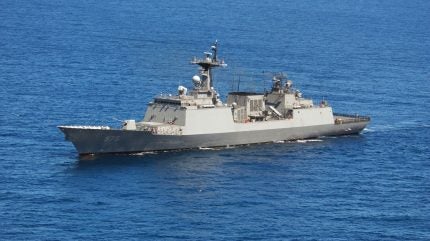
South Korea’s Defense Acquisition Program Administration has commenced a performance improvement program (PIP) for the Chungmugong Yi Sun-sin-class destroyers, also known as KDX-II.
The initiative aims to modernise key systems, with a focus on integrating indigenous technologies to ensure the navy’s fleet remains contemporary and effective.
This major upgrade programme for KDX-II destroyers will help strengthen naval readiness amid rising maritime tensions, according to GlobalData, a data and analytics company.
In December 2024, the US State Department sanctioned a $300m foreign military sales (FMS) to South Korea for KDX-II class destroyer enhancements.
This encompassed updates to the weapon direct system software, along with associated integration, installation, and support services.
The KDX-II destroyers, which feature a sea-keeping hull design licensed from Germany’s IABG, incorporate stealth technology to minimise infrared and radar signatures, enhancing survivability and protection against biochemical attacks.
The vessels, measuring 150 metres in length and displacing 4,800 tonnes at full load, can accommodate a crew of 200.
With approximately 23% of the Republic of Korea Navy’s ships over 20 years old, as per GlobalData’s Fleet Size dashboard, the upgrade is a component of a larger strategy to modernize the naval fleet to address evolving threats.
GlobalData Aerospace and Defense analyst Harpreet Sidhu said: “The replacement of outdated combat systems with advanced domestic alternatives is particularly significant, as it aligns with South Korea’s ambition to establish itself as a regional naval manufacturing powerhouse.
“With North Korea’s increasingly complex undersea threats and growing range of ballistic missiles arsenal, the integration of advanced sonar and missile systems improves anti-submarine and air-defence capabilities of the destroyer fleet. Additionally, this upgrade addresses vulnerabilities that were made public during high-profile exercises such as the RIMPAC 2022, where weaknesses around operational readiness owing to system malfunctions were brought to light.”
The PIP also includes the integration of advanced domestic technologies while selectively sourcing essential components like the MK 99 fire-control system through FMS.
This hybrid approach reflects a strategic balance between local innovation and global partnerships.
Sidhu concludes: “While the current program does not include a radar upgrade, it leaves room for future enhancements such as integrating advanced AESA radar systems like SPS-560K or AN/SPY-7. This multi-phased strategy demonstrates South Korea’s intention to develop capabilities of its naval platforms in line with technological breakthroughs it achieves over the future years, guaranteeing the fleet’s long-term viability.
“The KDX-II upgrades, in essence, are not just about modernising older naval platforms, but are a cornerstone of South Korea’s broader strategy to assert its presence in the increasingly contested waters of the Indo-Pacific.”



